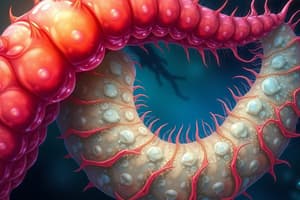Podcast
Questions and Answers
What are the main functions provided by the mesoderm in flatworms?
What are the main functions provided by the mesoderm in flatworms?
skeletal support, nutrient storage, motility, transport of materials, oxygen storage
Describe the different ways in which flatworms obtain nutrition.
Describe the different ways in which flatworms obtain nutrition.
Carnivores, Scavengers, Parasites
What are the types of flatworms based on their lifestyle?
What are the types of flatworms based on their lifestyle?
Free Living (e.g., Planaria) and Parasitic (e.g., Flukes and Tapeworms)
Describe the nervous system of flatworms.
Describe the nervous system of flatworms.
How do flatworms eliminate waste from their bodies?
How do flatworms eliminate waste from their bodies?
What is the level of organization of Platyhelminthes in terms of their body structure?
What is the level of organization of Platyhelminthes in terms of their body structure?
How do larger flatworms compensate for the lack of a body cavity?
How do larger flatworms compensate for the lack of a body cavity?
What is the primary mode of respiration for flatworms?
What is the primary mode of respiration for flatworms?
How do flatworms without an anus expel waste?
How do flatworms without an anus expel waste?
What is the body cavity type of Platyhelminthes?
What is the body cavity type of Platyhelminthes?
What is the primary method of circulation in Platyhelminthes?
What is the primary method of circulation in Platyhelminthes?
Flashcards are hidden until you start studying
Study Notes
Mesoderm
- The mesoderm is a loose tissue (parenchyma) that fills spaces between organs and body walls, providing:
- Skeletal support
- Nutrient storage
- Motility
- Transport of materials
- Oxygen storage
Nutrition
- Different types of nutrition:
- Carnivores
- Scavengers
- Parasites
- Types of platyhelminthes:
- Free living (e.g. Planaria)
- Parasitic (e.g. Flukes and Tapeworms)
Nervous System
- Rudimentary nervous system, more complex than jellyfish
- Features:
- Head with simple brain
- Lateral nerve cord with short cords running across
- Cerebral ganglion (nerve bundle in the head area)
- 2 eye spots (photosensitive, not true eyes)
- Auricles (sensors for surroundings)
Excretory System
- Used to remove ammonia waste
- Features:
- Flame cells (instead of kidneys) to remove excess water from the body
Characteristics of Platyhelminthes
- Bilaterally symmetrical animals
- Cephalization (head formation)
- Triploblastic (made up of three fundamental cell layers)
- Organ level of organization (not organ-system level)
- Flatworms
- Over 34,000 species
- Adults range from 1mm or less to 25m in size
Body Structure
- No body cavity other than the gut
- No anus
- Pharyngeal opening for both taking in food and expelling waste
- Gut is often highly branched in larger flatworms to transport food
- Constrained to be flat due to lack of body cavity
- Respiration occurs by diffusion
Habitat and Characteristics
- Live in marine, fresh water, and damp terrestrial habitats
- Acoelomate (do not have a true coelom)
- Have ectoderm, mesoderm (fluid-filled), and endoderm
- One opening for the digestive system (incomplete)
- Rely on diffusion for respiration, excretion, and circulation
- Many functions vary among species, whether free living or parasitic
Studying That Suits You
Use AI to generate personalized quizzes and flashcards to suit your learning preferences.




